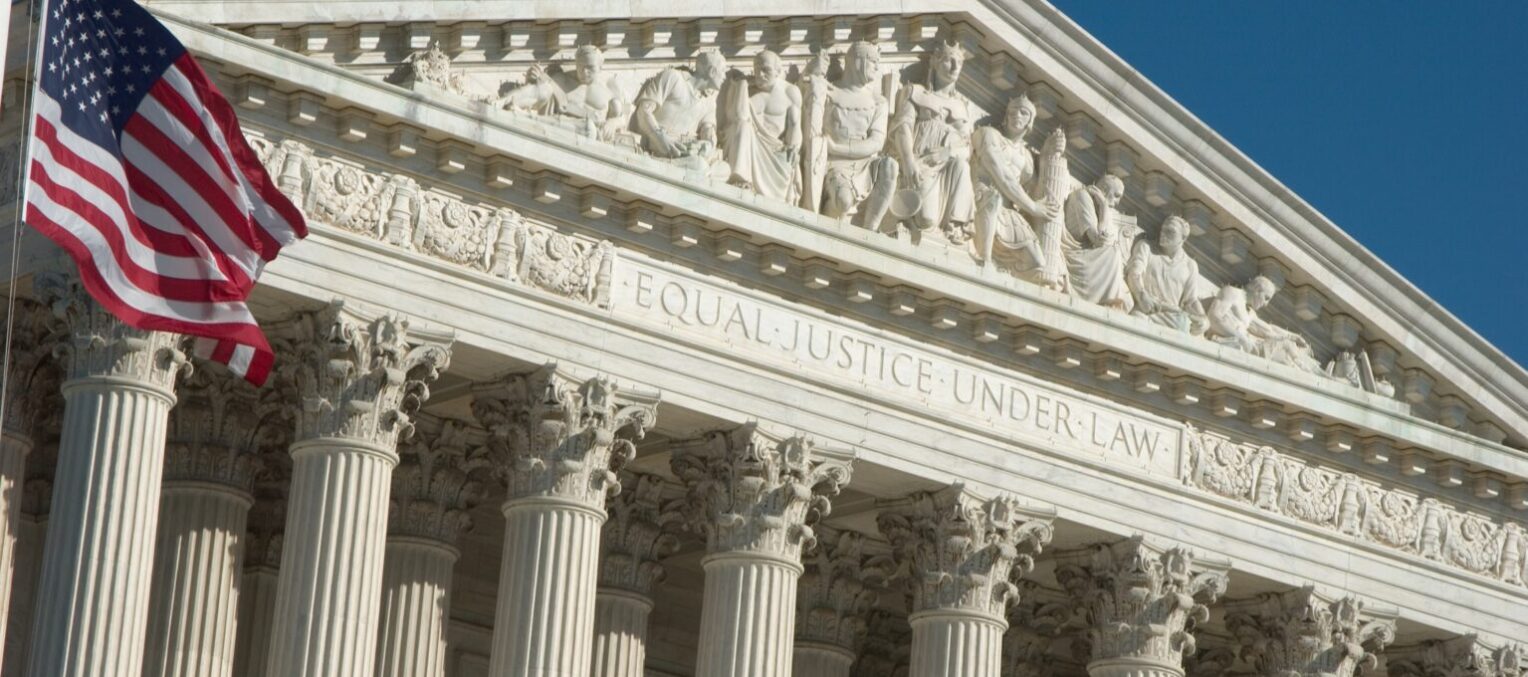
The recently completed U.S. Supreme Court session appears to have upended the administrative state in some pretty fundamental ways. While Loper Bright’s overruling of Chevron attracted the most headlines and hand-wringing, Jarkesy will have far-reaching effects across both the executive and judicial branches. Even seemingly “small” matters such as Ohio v. EPA and Corner Post will color agency rulemaking and enforcement. And Fischer v. United States could have an impact on statutory construction going forward.
In this post, we’ll examine how these opinions might present challenges for the Federal Communications Commission’s (FCC) recent digital-discrimination rules.
Section 60506 of the Infrastructure Investment and Jobs Act (IIJA) required the FCC to adopt rules “preventing digital discrimination of access based on income level, race, ethnicity, color, religion, or national origin.” [emphasis added] The law also required the FCC and the U.S. attorney general to “ensure that Federal policies promote equal access to robust broadband internet access service by prohibiting deployment discrimination.” [emphasis added]
Soon after the IIJA was enacted, FCC Chair Jessica Rosenworcel announced the formation of a digital-discrimination task force. Her announcement indicated that “final rules to facilitate equal access to broadband service that prevents digital discrimination and promotes equal access to robust broadband internet access” would be accomplished by “prohibiting deployment discrimination.”
Earlier this year, the FCC approved sweeping digital-discrimination rules that cover nearly every aspect of broadband service. Rather than focusing on deployment, the expansive rules also cover pricing, discounts, speeds, capacities, data caps, credit checks, marketing, and advertising.
Soon after the rules were issued, a half-dozen lawsuits were filed challenging the FCC’s order. The cases were consolidated and will now be heard by the 8th U.S. Circuit Court of Appeals. Early last week, the U.S. Justice Department (DOJ) and the FCC submitted their brief on the matter. And, as noted earlier, at week’s end, the Supreme Court issued opinions in multiple cases that could potentially make these challenges much more difficult for the FCC to defend.
Loper Bright
In Loper Bright Enterprises v. Raimondo, the Court jettisoned so-called Chevron Deference:
Chevron is overruled. Courts must exercise their independent judgment in deciding whether an agency has acted within its statutory authority, as the APA requires. Careful attention to the judgment of the Executive Branch may help inform that inquiry [e.g., Skidmore review]. And when a particular statute delegates authority to an agency consistent with constitutional limits, courts must respect the delegation, while ensuring that the agency acts within it. But courts need not and under the APA may not defer to an agency interpretation of the law simply because a statute is ambiguous.
At first blush, Loper Bright seems irrelevant to the FCC’s digital-discrimination rules. The FCC’s order does not mention Chevron, and the government’s brief to the 8th Circuit makes only one passing reference to Chevron:
Where, as here, “there is an express delegation of authority to the agency to elucidate a specific provision of the statute by regulation,” the Court gives the regulations “controlling weight unless they are arbitrary, capricious, or manifestly contrary to the statute.” Glover v. Standard Fed. Bank, 283 F.3d 953, 961 (8th Cir. 2002) (quoting Chevron, U.S.A., Inc. v. NRDC, Inc., 467 U.S. 837, 844 (1984)). Even outside the Chevron framework, “the interpretation of an agency charged with the administration of a statute is entitled to substantial deference.” Blum v. Bacon, 457 U.S. 132, 141 (1982).
Most notably, the FCC’s order concludes there is “little or no evidence in the legislative history of the Infrastructure Act or the record of this proceeding that impediments to broadband internet access service are the result of intentional discrimination.” If this is the case, the agency argues, then rules focused only on intentional discrimination would be more or less meaningless. Therefore, its rules must cover disparate impacts.
While the Court overruled Chevron, it embraced the older Skidmore standard of deference:
Perhaps most notably along those lines, in Skidmore v. Swift & Co., 323 U. S. 134 (1944), the Court explained that the “interpretations and opinions” of the relevant agency, “made in pursuance of official duty” and “based upon . . . specialized experience,” “constitute[d] a body of experience and informed judgment to which courts and litigants [could] properly resort for guidance,” even on legal questions. Id., at 139–140. “The weight of such a judgment in a particular case,” the Court observed, would “depend upon the thoroughness evident in its consideration, the validity of its reasoning, its consistency with earlier and later pronouncements, and all those factors which give it power to persuade, if lacking power to control.” Id., at 140.
There is no debate that Section 60506 gave the FCC authority to issue digital-discrimination rules. Indeed, the law mandated that the agency issue rules, and specified a timeline for doing so. There is debate, however, regarding how broad those rules should be and the FCC’s authority to enforce them. Understanding the extent of Skidmore deference is crucial here.
In most (but not all) cases, the FCC’s interpretation of Section 60506 is based on its reading of the statute, rather than the FCC’s “specialized experience” with broadband internet or discrimination. Loper Bright, however, makes clear that statutory interpretations are the sole province of the courts, not the agencies. Legal reasoning from the agency receives weight only insofar as the Court finds it persuasive.
In one area in which the FCC has expertise—the existence and pervasiveness of digital discrimination—the agency finds no evidence of intentional discrimination. As such, the Commission’s order reports, “Rather, we must conclude that such impediments are more likely driven by neutral policies or practices (i.e., business decisions) that have discriminatory effects.”
This is a rather massive logical leap, as it notes that, if the FCC can’t find intentional discrimination, then there must be unintentional discrimination, without inquiring whether what the agency is observing is discrimination at all. Thus, even where the FCC should have the expertise to inform the courts, the Commission resorts to mental gymnastics, thereby failing Skidmore’s “validity of its reasoning” test.
But more fundamentally, the agency’s legal reasoning is simply not persuasive. For instance, the FCC has to consistently misrepresent the Supreme Court’s analysis in Inclusive Communities to argue that they have been given clear authority to impose disparate-impact rules, downplaying the importance of the “otherwise” language the Court emphasized in that case. As we at the International Center for Law & Economics (ICLE) argued in our amicus brief with the Information Technology and Innovation Foundation (ITIF):
Inclusive Communities primarily based its opinion on the “otherwise make unavailable” language at issue, with a particular focus on “otherwise” creating a more open-ended inquiry. See Inclusive Communities, 576 U.S. at 534 (“Here, the phrase ‘otherwise make unavailable’ is of central importance to the analysis that follows”). Such language is absent in Section 60506. Moreover, the closest analogy for Section 60506’s “based on” language is the “on the ground of” language of Title VI of the Civil Rights Act, which also does not include the “otherwise” language found to be so important in Inclusive Communities. Compare 42 U.S.C. §2000d with Inclusive Communities, 576 U.S. at 534-35 (focusing on how “otherwise” is a catch-all phrase looking to consequences instead of intent). If the Court has found “grounded on” means only intentional discrimination, then it is hard to see how “based on” wouldn’t lead to the same conclusion.
Thus, since Section 60506 was drafted without “results-oriented language” and instead frames the prohibition against digital discrimination as “based on income level, race, ethnicity, color, religion, or national origin,” this would put the rule squarely within the realm of prohibitions on intentional discrimination. That is, to be discriminatory, the decision to deploy or not to deploy must have been intentionally made based on or grounded on the protected characteristic. Mere statistical correlation between deployment and protected characteristics is insufficient.
The FCC’s digital-discrimination rules are well outside the legal authority granted by the statute, in both their substance and their scope. In light of Loper Bright, the agency’s legal analysis will not receive Chevron deference, meaning its interpretation of the statute will have to stand on its own persuasive value. As will be argued in the next section, the FCC’s textual analysis is very weak, indeed.
Fischer
The FCC argues that “[t]he most natural reading of the statute… reaches all entities with the power to deprive consumers of ‘the equal opportunity to subscribe to an offered service’” Not only will this interpretation no longer receive Chevron deference, but it is almost certainly not the best understanding of the statute.
In Fischer v. United States, the Supreme Court analyzed whether a provision of the Sarbanes-Oxley Act of 2002 (intended to prevent bookkeeping abuses like those found in early 2000s corporate-accounting scandals at Enron and WorldCom) could be applied against defendants who allegedly participated in the Jan. 6th U.S. Capitol attack. The provisions at-issue impose criminal liability on anyone who corruptly “alters, destroys, mutilates, or conceals a record, document, or other object, or attempts to do so, with the intent to impair the object’s integrity or availability for use in an official proceeding,” including those who “otherwise obstructs, influences, or impedes any official proceeding, or attempts to do so.” [18 U. S. C. §1512(c)(1), (c)(2).]
The Court’s textual analysis in the case is actually very informative for how courts (and agencies) should understand statutory construction going forward. The Court found, in particular, that the “otherwise” language in §1512(c)(2) must be understood in the context of the rest of the statute. Namely, because (c)(1) only focuses on types of actions that “impair the integrity or availability or records, documents, or objects for use in an official proceeding,” (c)(2) is best understood as being related to those types of crimes, and not simply anything that would “otherwise” obstruct, influence, or impede an official proceeding or attempt to do so. “These approaches to statutory interpretation track the common sense intuition that Congress would not ordinarily introduce a general term that renders meaningless the specific text that accompanies it.”
Here, the FCC focuses on Section 60506(a)(2)’s language to argue the statute is aimed not at only broadband providers, but any entity that “might impede equal access to broadband internet access service on the bases specified in the statute.” This language is from a part of the statute clearly labeled “Statement of Policy,” and is not itself a grant of authority. As we argued in our amicus brief:
The statement of policy in Section 60506(a) is exactly that: a statement of policy. Courts have long held that statutory sections like Section 60506(a)(1) and (a)(3) using words like “should” are “precatory.” See Emergency Coal. to Def. Educ. Travel v. U.S. Dep’t of Treasury, 498 F. Supp. 2d 150, 165 (D.D.C. 2007) (“Courts have repeatedly held that such ‘sense of Congress’ language is merely precatory and non-binding.”), aff’d, 545 F.3d 4 (D.C. Cir. 2008). While the statement of policy helps illuminate the goal of the provision at issue, it does not actually give the FCC authority.
This is important, because the statute’s actual grants of authority should be read consistently with one another, just as the Court argues in Fischer. The entirety of the grants of authority under the statute read as follows:
(b)Adoption of rules
Not later than 2 years after November 15, 2021, the Commission shall adopt final rules to facilitate equal access to broadband internet access service, taking into account the issues of technical and economic feasibility presented by that objective, including—
(1)preventing digital discrimination of access based on income level, race, ethnicity, color, religion, or national origin; and
(2)identifying necessary steps for the Commissions to take to eliminate discrimination described in paragraph (1).
(c)Federal policies
The Commission and the Attorney General shall ensure that Federal policies promote equal access to robust broadband internet access service by prohibiting deployment discrimination based on—
(1)the income level of an area;
(2)the predominant race or ethnicity composition of an area; or
(3)other factors the Commission determines to be relevant based on the findings in the record developed from the rulemaking under subsection (b).
(d)Model State and local policies
The Commission shall develop model policies and best practices that can be adopted by States and localities to ensure that broadband internet access service providers do not engage in digital discrimination.
As can be seen when all of these provisions are read together, the clear focus of Section 60506 is on deployment discrimination by broadband providers. For instance, (c) clearly focuses on “prohibiting deployment discrimination” and (d) on stopping “broadband internet access service providers” from engaging in digital discrimination. So when subsection (b) focuses on “preventing digital discrimination of access,” the most natural reading in this context suggests it is a reference to discrimination by broadband providers in their deployment decisions.
Moreover, in Fischer, the Court found the background history of the Enron accounting scandal was important to understand the provision’s purpose, finding that “[i]t would be peculiar to conclude that in closing the Enron gap, Congress created a catch-all provision that reaches beyond the scenarios that prompted the legislation.”
Here, it would also be quite peculiar to have Section 60506 of the IIJA reach entities that are not involved in the deployment of broadband, as the statute as a whole divides authority among different agencies to deal with the problems of broadband deployment, affordability, and discrimination. A limited rule aimed at intentional discrimination by broadband providers in deployment decisions makes the most sense of the statute as a whole. As we wrote in our amicus brief:
The IIJA divided broadband policy priorities between different agencies and circumscribes the scope of each program or rulemaking it delegates to agencies. Section 60102 addressed the issue of universal broadband deployment by creating the Broadband Equity, Access, and Deployment (BEAD) Program. See IIJA §60102. The statute designated the National Telecommunication and Information Administration (NTIA) to administer this $42.45 billion program with funds to be first allocated to deploy broadband service to all areas that currently lack access to high-speed broadband Internet. See IIJA §60102(b), (h). BEAD is, therefore, Congress’s chosen method to remedy disparities in broadband deployment due to cost-based barriers like low population density. Section 60502 then created the Affordable Connectivity Program (ACP), which provided low-income individuals a $30 per month voucher, and delegated its administration to the FCC. See IIJA §60502. ACP is, therefore, Congress’s chosen method to remedy broadband affordability for households whose low income is a barrier to broadband adoption. Title v of Division F of the IIJA goes on to create several more broadband programs, each with a specific and limited scope. See IIJA § 60101 et seq.
In short, Congress was intentional about circumscribing the different problems with broadband deployment and access, as well as the scope of the programs it designed to fix them. Section 60506’s authorization for the FCC to prevent “digital discrimination” fits neatly into this statutory scheme if it targets disparate treatment in deployment decisions based upon protected status—i.e., intentional harmful actions that are distinct from deployment decisions based on costs of deployment or projected demand for broadband service.
Put simply, the FCC’s interpretation fails to uphold the statutory-construction principles the Court illustrates in Fischer—namely, that the statute as a whole should be read both in the context of each subsection, and its overall structure and purpose.
Jarkesy
In enforcing its digital-discrimination rules, the FCC’s order states that “the Commission will bring to bear its full suite of available remedies, including the possibility of monetary forfeitures.”
Petitioners challenging the rules at the 8th Circuit argue that Section 60506 does not include explicit authorization for any penalties. The petitioners argue the agency’s mandate to “prevent” and “eliminate” digital discrimination may implicitly authorize it to impose limited forward-looking remedies, but not backward-looking penalties like monetary forfeitures. The government counters that “preventing” digital discrimination involves deterring discrimination in the first place, and that money penalties have long been accepted as a means to achieve deterrence.
As noted in our earlier post, the FCC’s procedure for enforcing its digital-discrimination rules puts the commission in the position of both prosecutor and judge.
- The FCC will determine the nature of an alleged disparate impact and determine whether the identified policy or practice is causing the disparate impact.
- “[T]he entity under investigation will have the burden of proving to the Commission that the … practice in question is justified” by “genuine issues of technical and economic feasibility.” The FCC’s report and order clearly states that the agency does not consider profitability a “genuine issue,” indicating “we weigh profitability separately from technical or economic feasibility.”
- The commission will determine whether a less-discriminatory alternative policy or practice is reasonably available and achievable, and identify any such alternative. If so, then that policy or practice “will not be deemed justified by genuine issues of technical or economic feasibility.”
- If the policy or practice has a disparate impact and cannot be justified to the FCC’s satisfaction, the commission “decides whether to pursue a monetary forfeiture or other remedies.”
The Supreme Court’s opinion in SEC v. Jarkesy may upend the FCC’s enforcement process. In Jarkesy, the Court ruled that, when the U.S. Securities and Exchange Commission (SEC) seeks civil penalties against a defendant for securities fraud, the defendant is entitled under the Seventh Amendment to a jury trial and, thus, the agency must bring the action in an Article III federal court. This decision was based on several factors:
- The Seventh Amendment guarantees a right to a jury trial for “[s]uits at common law,” which includes statutory claims that are “legal in nature” (e.g., whether the cause of action resembles common-law causes of action, and whether the remedy is the sort that was traditionally obtained in a court of law);
- The civil monetary penalties the SEC sought against Jarkesy are the “prototypical common law remedy,” therefore the SEC’s action was legal in nature; and
- The civil monetary penalties sought by the SEC were designed to “punish and deter” the wrongdoer rather than to “restore the status quo.”
The monetary penalties anticipated by the FCC’s digital-discrimination order line up with Jarkesy:
- U.S. anti-discrimination laws are rooted in common law, especially those relating to common carriage, and monetary remedies have been a traditional remedy in those cases;
- The monetary penalties the FCC is anticipated to seek are a “prototypical common law remedy;” and
- As the government notes in its brief, the monetary penalties are designed to punish and deter wrongdoers, concluding “monetary forfeitures serve an important deterrent function.”
The FCC faces a daunting task in differentiating its enforcement procedure from the SEC’s in Jarkesy. Thus, it is likely that the 8th Circuit would vacate this portion of the order and, on remand, require the FCC to develop a process that involves the right to a jury trial before an Article III court.
If that is the case, assuming the FCC’s claim of authority to enforce disparate-impact allegations survives, the adjudication process will likely be more in line with Inclusive Communities’ burden shifting between plaintiffs and defendants.
Ohio v EPA
In Ohio v. EPA, the Supreme Court upheld a preliminary injunction against an Environmental Protection Agency (EPA) rule, finding that it was likely the plaintiffs could show the rule was arbitrary and capricious. The Court explained:
An agency action qualifies as “arbitrary” or “capricious” if it is not “reasonable and reasonably explained.” FCC v. Prometheus Radio Project, 592 U. S. 414, 423. Thus, the agency must offer “a satisfactory explanation for its action[,] including a rational connection between the facts found and the choice made” and cannot simply ignore “an important aspect of the problem.” Motor Vehicle Mfrs. Assn. of United States, Inc. v. State Farm Mut. Automobile Ins. Co., 463 U. S. 29, 43.
Here, the FCC could also face challenges for failing to offer a satisfactory explanation of an important aspect of the problem presented in its digital-discrimination rules—namely, that the order will actually lead to outcomes inconsistent with the IIJA, because it will diminish investment incentives in broadband deployment and adoption. We anticipated just this sort of argument in our amicus brief:
[T]he purposes of the broadband provisions of the IIJA are to encourage broadband deployment, enhance broadband affordability, and prevent discrimination in broadband access. Put simply, the purpose is to get more Americans to adopt more broadband, regardless of income level, race, ethnicity, color, religion, or national origin. The FCC’s Order should curtail discrimination, but the aggressive and expansive police powers the agency grants itself will surely diminish investments in broadband deployment and efforts to encourage adoption. We urge the Court to vacate the Order and require the FCC to adopt rules limited to preventing intentional discrimination in deployment by broadband Internet access service providers. More narrowly tailored rules would satisfy Section 60506’s mandates while preserving incentives to invest in deployment and encourage adoption. Cf. Cin. Bell Tel. Co. v. FCC, 69 F.3d 752, 761 (6th Cir. 1995) (“The FCC is required to give [a reasoned] explanation when it declines to adopt less restrictive measures in promulgating its rules.”). But the current Order is arbitrary and capricious because the predictable results of the rules would be inconsistent with the purpose of the IIJA in promoting broadband deployment. See Motor Vehicle Mfrs. Ass’n v. State Farm Mutual Auto. Ins. Co., 463 U.S. 29, 43 (1983) (“[A]n agency rule would be arbitrary and capricious if the agency has… offered an explanation for its decision that runs counter to the evidence before the agency, or is so implausible that it could not be ascribed to a difference in view of the product of agency expertise”).
The FCC attempts to rebut this by arguing that the commission retains discretion to adjudicate issues of economic and technical feasibility through its informal complaint process. But this is exactly the problem: the FCC’s rules render presumptively illegal nearly anything done by broadband providers (and other covered entities) that can be correlated with income or other protected characteristics.
This makes everything subject to the FCC’s review process, if they choose to initiate it, and makes the commission the central planner of all things related to broadband access. This would surely dissipate private investment incentives from broadband providers, who can’t ever be sure they are on the right side of the law. Less investment means less broadband deployment and adoption, which contradicts the IIJA’s overall purpose. The FCC’s order failed to offer a reasonable response to this important aspect of the problem.
Corner Post
In Corner Post Inc. v. Federal Reserve, the Supreme Court ruled that an Administrative Procedure Act (APA) claim is not time-barred by the six-year statute of limitations until six years pass after the plaintiff is injured by a final agency action. Even assuming the FCC’s rules are upheld in the face of the legal challenges brought by broadband providers, the rules could also affect other “covered entities” in the future who may wish to bring an APA claim.
As discussed above, the digital-discrimination rules apply to any entity that “might impede equal access to broadband internet access service on the bases specified in the statute.” Outside of the Broadband Equity, Access, and Deployment (BEAD) Program, the Universal Service Fund (USF), and “future broadband funding programs that account for digital discrimination of access rules,” the FCC’s digital-discrimination order offers no “safe harbors” to entities, policies, or practices. As of today, there is no way to tell what entities the FCC may bring under its purview.
In its brief, the FCC handwaves at this problem:
[I]n generally evaluating complaints involving non-providers, the Commission made clear that it “will consider … the closeness of the relationship between that entity’s policies and practices and the provision of broadband service.” App. __ (Order ¶ 87). Accordingly, there is no reason to think that enforcement of the digital-discrimination rules threatens “the bank that does not permit direct debits” or “the local government that restricts zoning for towers.”
Even in this answer, the FCC asserts that it retains full authority to determine the “closeness” of the relationship between the asserted covered entity and the provision of broadband service. If the commission does in the future pull in entities that are currently unaware of the rule’s provisions, Corner Post makes clear that those potential plaintiffs will not be time-barred if they bring the claim within six years of the final rule being applied to them.
Conclusion
The Supreme Court has chartered a new course in administrative law this term. The full effects of these decisions remain unknown. But it seems a fair prediction that the FCC will likely have a much more difficult time defending legal challenges to its digital-discrimination rules.





